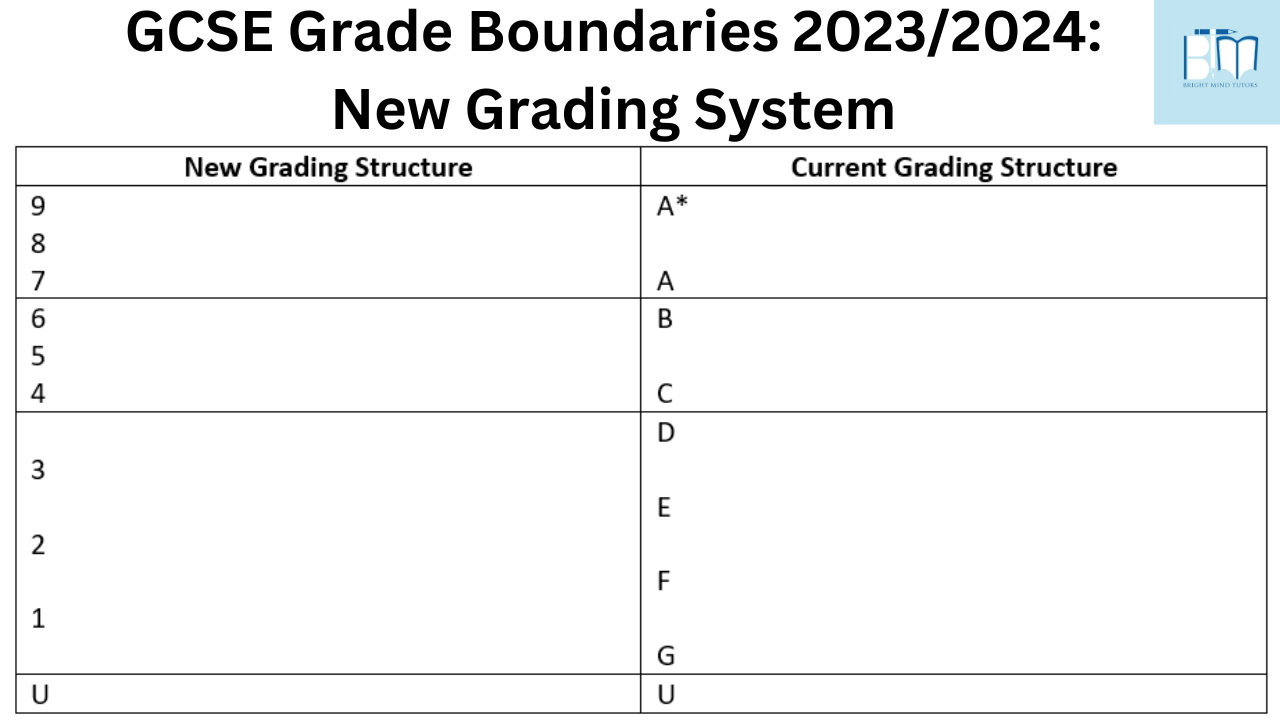The GCSE grade boundaries changed from A*-G to 9-1 starting in 2017. Maths, English language, and English literature were the first subjects to adopt the new system, followed by more subjects in 2018, and all remaining subjects by 2020. This post examines the 9-1 grading system and reformed GCSEs, explaining how grade boundaries are set, the distribution of student grades, and how the new grades compare to the old ones.
Comparison of New and Old Grading Systems
The new grading system ranges from 9 to 1, with 9 being the highest grade and 1 being the lowest. In contrast, the old system used letter grades from A* to G.
The new system provides more differentiation at the higher end of the scale. Grades 4-6 correspond to the old grades B and C, while grades 7-9 align with the old A and A* grades. Notably, grade 9 is considered higher than an A*, awarded to roughly the top 20% of students who achieve a grade 7 or above in their GCSEs.
| New Grading Structure | Current Grading Structure |
| 9
8 7 |
A*
A |
| 6
5 4 |
B
C |
|
3
2
1
|
D
E
F
G |
| U | U |
The New GCSE Grading System 2023-24
– Grades 9, 8, and 7 equal the old grades A* and A.
– Grades 6, 5, and 4 correspond to the old grades B and C.
– A pass requires at least a Grade 4 or Grade 5.
– Grades 1 to 3 are comparable to the old grades D to G.
– The U grade, meaning “ungraded,” remains unchanged.
Grade Specifics:
– Grade 9: For students performing exceptionally well, typically the top 5% of the cohort (equivalent to a high A*).
– Grade 8: Equal to a low A* or high A.
– Grade 7: Equal to a low A.
– Grade 6: Equal to a high B.
– Grade 5: Equal to a low B or high C.
– Grade 4: Equal to a low C (standard pass).
– Grade 3: Equal to a D or high E.
– Grade 2: Equal to a low E or high F.
– Grade 1: Equal to a low F or G.
– U: Ungraded.
Alignment with the Old System:
– The bottom of Grade 1 matches the bottom of Grade G.
– The bottom of Grade 4 matches the bottom of Grade C.
– The bottom of Grade 7 matches the bottom of Grade A.
This alignment ensures continuity and fairness, making it easier for educational establishments and employers to compare the old and new grades. For instance, a student who would have got at least a Grade C under the old system will now get at least a Grade 4. If you are looking to get high grades in GCSE maths, you can get help from GCSE Maths Tutor.
Pass Standards:
– Previously, a Grade C was considered a pass at GCSE, but now translated to a Grade 4 (standard pass).
– Grade 5 is labelled a “good pass,” and schools are accountable for the percentage of students achieving Grade 5 or higher.
Exam Papers:
– The foundation paper covers Grades 1-5.
– The higher paper covers Grades 3-9.
Why has the GCSE grading system changed?
The GCSEs in England have been reformed to be more rigorous. All courses are now linear, meaning exams are taken at the end of the course rather than in modules throughout. Additionally, there is less coursework, and the content is more demanding, aiming to align English standards with those of high-performing countries.
Changing the grading system clearly signals these course changes. The new system is intended to give sixth forms, colleges, universities, and employers a clearer understanding of a student’s level, allowing for finer distinctions between grades like 7, 8, and 9. Furthermore, to achieve high grades in GCSE Physics, get guidance from GCSE Physics Tutor.
What are the GCSE grade boundaries?
The GCSE grade boundaries indicate the minimum marks a student needs to achieve to receive a specific grade. These boundaries vary for each subject and can change slightly each year to maintain fairness for students. Each year, senior examiners set the grade boundaries, which then determine whether a student earns grades 1, 2, 3, and so on.
How Do the GCSE Grade Boundaries Work?
Exam boards aim to ensure that achieving a particular grade is consistent in difficulty from year to year. If an exam paper is harder than in previous years, the grade boundaries are adjusted downwards. This principle is called Comparable Outcomes.
Grade boundaries for each subject are set after the exams have been taken and all marking is completed. Senior examiners consider several factors when deciding on these boundaries, including:
– Feedback from examiners about the specific paper
– Question papers from previous years
– Data on the previous achievements of the student cohort
– Historical statistics
Examiners pay close attention to the work of students near the grade boundaries to decide where these boundaries should be set.
When are the GCSE grade boundaries released?
Grade boundaries are released on GCSE results day. Previously, like A-Level boundaries, they were made available before results day, but this practice was changed to reduce stress among students trying to predict their grades. You can find grade boundaries from previous years on the websites of each exam board.
Moreover, continue receiving such information at Bright Mind Tutors.
Other Useful Links:

